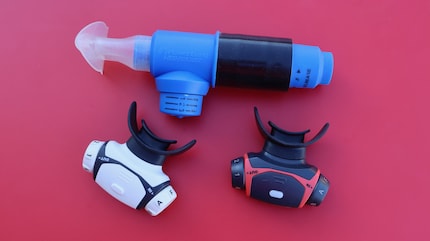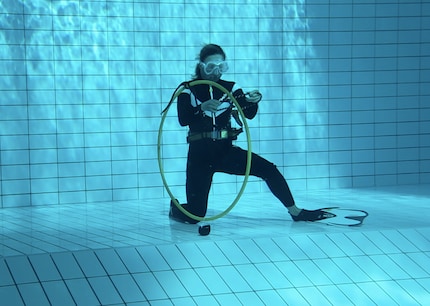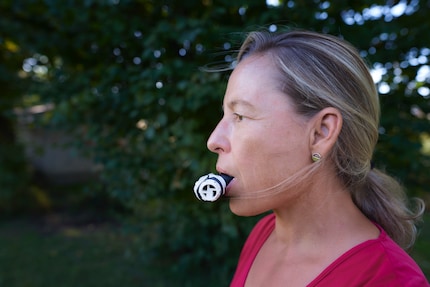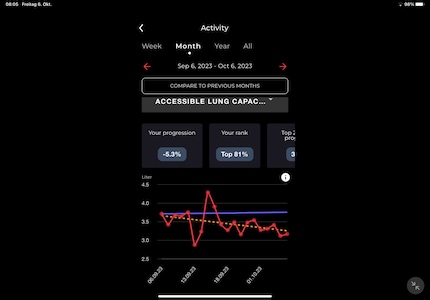

Airofit Pro 2.0 review: build your breathing muscles from the comfort of your sofa
Despite my long-held fascination for breathing training, I’ve never managed to keep it up for long. Until the Airofit Pro 2.0 came on the scene, that is. Now, with my enthusiasm rekindled, I’m enjoying doing daily breathing exercises. Even so, the device does have one downside.
It’s amazing how much can change in a relatively short period of time. Three years ago, I started using Airofit’s first breathing trainer. Eventually, however, my motivation dried up. At the time, the breathing trainer exercises seemed unusual to me, and I wasn’t sure if my efforts would pay off. Now that I’ve returned to my breath coaching regime, I’ve been well and truly swept up in training fever.

The Airofit is a palm-sized breathing trainer fitted with a rubber mouthpiece. The inside is kitted out with membranes, whose resistance you can adjust to different levels via dials on the sides of the device. This allows you to do targeted exercises that you can tailor yourself. Airofit’s latest model is available in two varieties: the Airofit Active and the Airofit Pro 2.0. I opted to try the Pro version, as the app-driven, personalised workouts with themes ranging from free-diving to running to swimming piqued my interest. Without the app, I’d honestly be pretty clueless about which method to use and how often I’d need to train to make my breathing more efficient.
Past attempts proved to be a waste of breath
Full disclosure: this wasn’t my first rodeo with a breathing trainer. More than a decade ago, I tried using a Powerlung – a device that now seems positively antiquated. But I quickly lost interest in using that trainer too.

Source: Siri Schubert
Things couldn’t be more different now. I started training with the new Airofit Pro 2.0 a little over a month ago, and with the exception of two or three days, I haven’t missed a session. After completing the recommended exercises, I often do extra ones just for the fun of it. Why the newfound enthusiasm, you ask? I’d love to say it’s because the new version of the Airofit Pro is so much better and easier to use than the previous one. The device, however, hasn’t exactly received a major makeover. There was also a slight technical hiccup, but more on that later.
Diving reawakens my training zeal
My newly rekindled enthusiasm for respiratory training is largely down to my keen interest in and knowledge of the subject of breathing. In free-diving, breathing calmly and maximising usable lung volume play a crucial role. The main way to achieve this is by making the diaphragm more flexible, but boosting the flexibility of the intercostal muscles (the muscles between the ribs) also helps. This gives the lungs more room to expand within the chest. The exercises Airofit offers are supposed to improve this flexibility.

Source: Siri Schubert
The benefits of respiratory muscle training
Strength training exercises for the respiratory muscles (like the ones the breathing trainer offers) are also useful. They’ve been shown to benefit blood pressure and other health-related parameters. As an athlete, there’s one positive effect I find particularly important. If the respiratory muscles get tired, an effect known as the metaboreflex (website in German) starts to hamper the performance of the leg muscles. After just four weeks of breath-based resistance training, 800-metre runners demonstrated improved running performance. A 2021 meta-analysis of six different studies, albeit each with a small sample size, confirmed that regular training with a respiratory resistance device can improve endurance in various sports. As you might expect, people who’re less fit see more drastic respiratory improvements after breath training than elite sportspeople, who’ve basically already exhausted their athletic potential.

Source: Stefan Munsch
Guided breathing exercises to help you unwind
It remains to be seen whether the device (which bears a passing resemblance to a baby’s dummy) will improve my athletic performance. For me, it’s another factor that tips the scales. As someone with a lot of energy, I sometimes find it hard to switch off. Whenever I’ve tried typical meditation, it’s always been fruitless. I’m just too fidgety for it. It’s different when I’m using the Airofit. The app gives me precise instructions on inhaling and exhaling, a red ball on the display inflating in time with my breaths. This encourages me to breathe evenly, which makes me relax.

Source: Stefan Munsch
I also really like the variety of breathing exercises designed to boost endurance. The personal training plan allowed me to choose a particular focus for my exercises. Since I’m currently gearing up to do a half marathon, I went for running. Every day, the app suggests two exercises intended to support me. Sometimes, I work on building my inhalation strength by breathing in against strong resistance. Other times, the exercises involve inhaling to a set rhythm. Every so often, I squeeze in a relaxation session in «Mindfulness» or «Concentration» mode.
How the Airofit Pro 2.0 differs from its predecessor
The Airofit Pro 2.0 offers 17 training programs for performance enhancement or relaxation. Short video tutorials show you how to complete the exercises. The device connects to your smartphone or iPad via Bluetooth. Unlike when I was using the predecessor model, whose connectivity sometimes frustrated me, I never have any trouble pairing the Pro 2.0. Another plus is the improved battery performance (another of the predecessor’s weak spots) which lasts at least five days. If you want, you can also integrate the information from your Airofit into Apple Health. Plus, the device is very easy to clean. You just take out the electronic control unit, rinse the Airofit under running water and clean it once a week with a small amount of gentle washing-up liquid.
Here comes the «but»
As keen as I am on the breathing trainer, I’m not quite as taken with the app. After running my current training program for 14 out of 28 days, it restarted at day one. According to Airofit, between three and five per cent of users have experienced the same issue. The company’s working on a solution. I obviously would’ve liked to see the full 28 days in the countdown as well, but since I can track every workout in the timeline, it’s not that big a deal. According to the manufacturer, the measurements from my training sessions will continue to be incorporated into my training plan – and that’s the more important thing.

Source: Siri Schubert
Another element of the app that confused me was how it measures progress. If the app is to be believed, my usable lung volume has been steadily decreasing since I started training a month ago. This is despite the fact I’ve been following the instructions, performing the lung test every morning on an empty stomach, before starting the breathing exercises. This considered, I’d guess we’re talking about a measurement error here rather than an actual decrease.
Speaking to Airofit over the phone, I find out that the way you breathe also influences the measurements. The company explained that anyone consistently performing the test with about 80 per cent of the maximum respiratory pressure can expect comparable results. It would’ve been nice to have that information in the app. In fact, it generally wouldn’t hurt to give the breathing exercises some more context. It’d be helpful to find out why «Control» is always the first exercise I’m assigned each session. Or how my usable lung volume influences exercise selection. In instances where you don’t see any progress, it’d also be useful to get a signal from the app if you need to take a rest day. More information and explanations would definitely make the app more useful to me. Since the app is continuously under development, future versions may well be equipped to give more context.
The cheaper version of the Airofit
If you’re not as bothered about the app or personalised training programmes, there’s also a cheaper version of the device – the Airofit Active.
The Active doesn’t look all that different to the Pro. Since it can’t be connected to the app via Bluetooth, however, it doesn’t provide personalised training sessions or progress measurement. Instead, the app offers six basic exercises and simple tutorials on how to perform them. Whether you go for the Airofit Active or the Airofit Pro 2.0 is essentially a question of how targeted you want your training sessions to be and how important the feedback and measurements are to you. And sure, the amount you’re willing to spend will factor into the decision too.
Verdict: fun training sessions, but the app has room for improvement
Since I don’t have access to objective measurement criteria besides the ones available in the app, I can’t tell whether the training has impacted my lung volume and performance. What I can judge, however, is the effect it’s had on my relaxation and recovery. And this is where I’ve found the Airofit Pro 2.0 immensely helpful. Focused breathing calms me down, and I’ve noticed that I now take care to breathe calmly and evenly as I’m going about my day. And in my book, that’s more than enough reason to keep using the Airofit Pro 2.0. After all, conscious breathing and good recovery are said to boost athletic performance.
Header image: Siri Schubert
Research diver, outdoor guide and SUP instructor – I love being in, on and around water. Lakes, rivers and the ocean are my playgrounds. For a change of perspective, I look at the world from above while trail running or flying drones.



